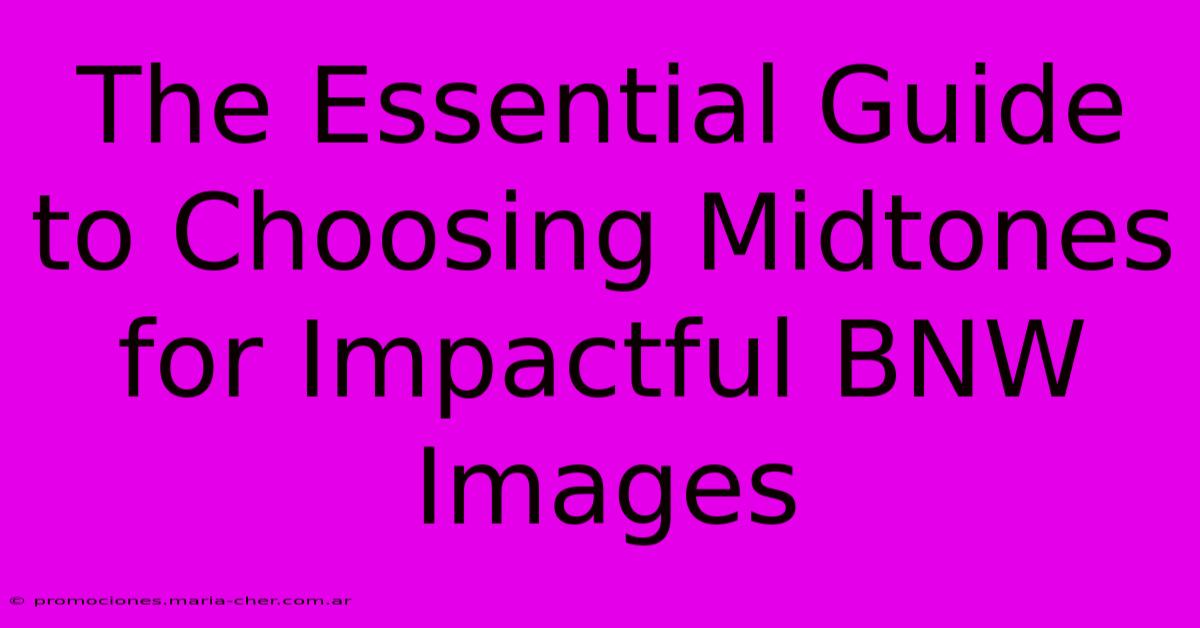The Essential Guide To Choosing Midtones For Impactful BNW Images

Table of Contents
The Essential Guide to Choosing Midtones for Impactful Black and White (BNW) Images
Converting your images to black and white isn't just about stripping away color; it's about mastering the art of light and shadow, and crucially, midtones. These often-overlooked shades hold the key to creating impactful BNW images that resonate with emotion and depth. This guide will walk you through the nuances of midtone manipulation for truly stunning monochrome results.
Understanding the Role of Midtones in BNW Photography
Before diving into techniques, let's clarify what midtones are. They represent the grayscale values between pure black and pure white. These subtle gradations are responsible for the richness, texture, and overall mood of your BNW photograph. They determine how different elements within the scene interact and how your eye moves through the image. Unlike stark high-contrast images, a well-managed midtone range creates depth and avoids a flat, lifeless look.
Why are Midtones Important?
- Depth and Dimension: Midtones add depth to your subjects, creating a sense of three-dimensionality that's often lost in overly contrasty images. They allow for subtle transitions between light and shadow, creating a more natural and realistic representation of your scene.
- Texture and Detail: Fine details, textures, and subtle variations in tone are best revealed through careful management of midtones. Losing these nuances in a high-contrast conversion results in a loss of information and visual interest.
- Mood and Atmosphere: The selection and manipulation of midtones drastically impacts the overall mood of your photograph. A richer midtone range can evoke feelings of warmth and nostalgia, while a more muted range might convey a sense of mystery or melancholy.
Mastering Midtone Manipulation: Techniques and Tools
Several methods allow you to control and enhance midtones in your BNW images. Experimentation is key to finding your preferred workflow.
1. In-Camera Techniques:
- Exposure: Proper exposure is paramount. Overexposed or underexposed images will leave you with limited dynamic range in the midtones, restricting your post-processing options. Shoot for optimal exposure in the camera to maximize the information captured.
- Lighting: The direction and quality of your light source directly impact your midtone range. Soft, diffused light often produces a broader range of smoother midtones, while harsh, directional light can lead to higher contrast with fewer midtone details.
2. Post-Processing Techniques:
- Curves Adjustment: The curves tool in photo editing software (like Adobe Lightroom or Photoshop) offers the most precise control over your midtones. You can selectively lift or darken specific areas of the midtone range to enhance contrast, texture, or mood.
- Levels Adjustment: Similar to curves, the levels tool allows for broad adjustments to the overall tonal range. By manipulating the midtone slider, you can refine the distribution of gray values.
- Split Toning: This technique allows separate control over the highlights and shadows, indirectly influencing the midtones. By subtly altering the colors used in split toning, you can subtly shift the overall mood and tonal balance of your monochrome image.
- Black and White Conversion Tools: Many programs offer advanced BNW conversion tools that go beyond simple desaturation. These tools allow targeted adjustments to the tonal response of different color channels, subtly affecting the final midtone range in your BNW image.
Examples of Midtone Application in BNW Photography
Let's consider different scenarios:
- Portrait Photography: Subtle midtones are crucial in portrait photography. They preserve skin texture and detail, adding a sense of realism and depth to your subject's features. Overly harsh contrast can flatten the image and obscure crucial details.
- Landscape Photography: In landscapes, midtones are essential for rendering textures of clouds, foliage, and rocks. By carefully manipulating midtones you can emphasize details while still maintaining a balanced and visually appealing image.
- Street Photography: Street photography often benefits from a balanced range of midtones, allowing the subtleties of the scene, from textures of buildings to the nuances of human expression, to come through.
Conclusion: Embrace the Nuances of Midtones
Mastering midtones is a journey of experimentation and refinement. By understanding their role in shaping your BNW images, and by utilizing the various techniques described above, you can elevate your monochrome photography to a new level of artistry. Don't be afraid to experiment with different approaches to find your unique style and create BNW images that are both technically proficient and emotionally resonant. Remember that practice and a keen eye for detail are essential ingredients for success.

Thank you for visiting our website wich cover about The Essential Guide To Choosing Midtones For Impactful BNW Images. We hope the information provided has been useful to you. Feel free to contact us if you have any questions or need further assistance. See you next time and dont miss to bookmark.
Featured Posts
-
Nail Art Nirvana Stunning Mermaid Designs With Dnds Gel Polish Hues
Feb 10, 2025
-
Daisy Dreamin How To Get The Perfect Pastel Manicure With Dnd Gel
Feb 10, 2025
-
Unveiling The Ideal You Tube Video Download Size Unlocking Crystal Clear Clarity
Feb 10, 2025
-
Unlock The Gateway To Convert Kit Success A Step By Step Guide To Domain Verification Google Discovery Masterclass
Feb 10, 2025
-
Sew Or Sow The Ultimate Guide To Clear Confusion
Feb 10, 2025
